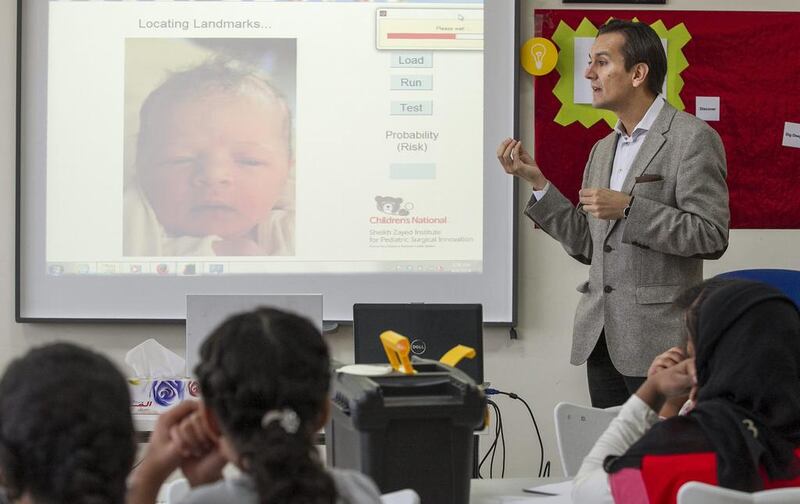ABU DHABI // Facial recognition technology to screen newborns for Down syndrome, an “Iron Man” robotic skeleton to help paralysed people walk and a “power steering” system for the joints.
These are just some of the medical breakthroughs made by a children’s hospital unit established in the name of the founding President, Sheikh Zayed.
The recognition system could become a smartphone app with which a simple snapshot would help to diagnose Down syndrome.
Software to detect the disorder is in its early stages but it has infinite possibilities, said Dr Kevin Cleary, technical director of bioengineering at the Sheikh Zayed Institute for Paediatric Surgical Innovation in Washington DC.
The centre was established with a gift of US$150 million, more than Dh550m, from Abu Dhabi.
Dr Cleary held a series of workshops for high-school pupils in Abu Dhabi as part of TechQuest, an initiative that introduces them to science, technology and maths.
“It is quite exciting. This is technology that can be widely and inexpensively distributed,” he said.
“What this computer screening does is take a picture of the newborn baby’s face and the software program segments where the eyes are, where the nose is, where the lips are.
“It then computes distances between those features and it looks at symmetry. Eventually this could be an app on your iPhone where you take a picture of the newborn baby and send it to this site and they tell you the probability of whether your child should undergo genetic screening.”
Students taking part in TechQuest’s healthcare module also heard from Dr Cleary’s colleague, Dr Marius Linguraru, who is a principal investigator in the Bioengineering Initiative of the institute. Part of his role entails developing tools for computer-aided diagnosis.
Down syndrome affects one in every 319 babies born in the UAE, according to a study conducted by the Centre for Arab Genomic Studies, a division of the Sheikh Hamdan bin Rashid Al Maktoum Award for Medical Sciences. The worldwide average is one in 1,100 births.
Early detection and intervention is vital as babies born with the disorder are at risk of medical conditions such as heart defects, leukaemia, infectious diseases, dementia and obesity.
A diagnosis of Down syndrome after birth is based initially on physical signs such as a short neck, flattened facial profile and nose and a small head, ears and mouth.
But it is estimated that the accuracy of paediatricians in detecting Down syndrome in a newborn is between 50 and 60 per cent, while the snapshot results in more than 95 per cent accuracy.
Genetic testing is also limited by cost and often a lack access, said Dr Cleary.
Even when testing is available, blood analysis of chromosomes is expensive and performed only if the child is suspected to have a genetic disorder, leaving many without adequate care.
Dr Marshall Summar, chief of genetics and metabolism at the Children’s National Medical Centre – with which the institute is affiliated – said the software would make sophisticated genetic expertise widely and affordably available.
“The accuracy of our system to detect Down syndrome is 96 per cent,” he said. “This software works, it just needs training.”
The centre works with the UAE on knowledge sharing. As part of the exchange, two Emirati students from Al Ain will be joining the genetics and paediatrics team at the institute in the summer on a six-year scholarship.
Rehabilitation robotics to aid disabled children are also among the advances being made at the institute.
These could help patients with Duchenne muscular dystrophy, a muscle-wasting genetic disorder, said Dr Cleary.
“So if we can develop a robotic exoskeleton – kind of like Iron Man – to provide assistance in walking, we think that could be better.”
The research team, working with Dr Ahsan Khandoker, assistant professor of biomedical engineering at Khalifa University, an affiliate of the US institute, is also working on robotic exoskeleton devices that could assist in therapy of the foot, knee, hip and other joints.
“Kind of like power steering for your joints,” said Dr Cleary.
“The mission of our institute is to make paediatric surgery more precise, less invasive and pain free. Besides the fact this is cool stuff.”
This work would not have been made possible without the generous funding from Abu Dhabi, he said.
“In the future we want to continue to partner with Abu Dhabi.”
The $150m donation from the UAE was announced in 2009 to fund the establishment of the institute – the largest such grant ever given to paediatric surgery. It officially opened in June 2011.
jbell@thenational.ae





